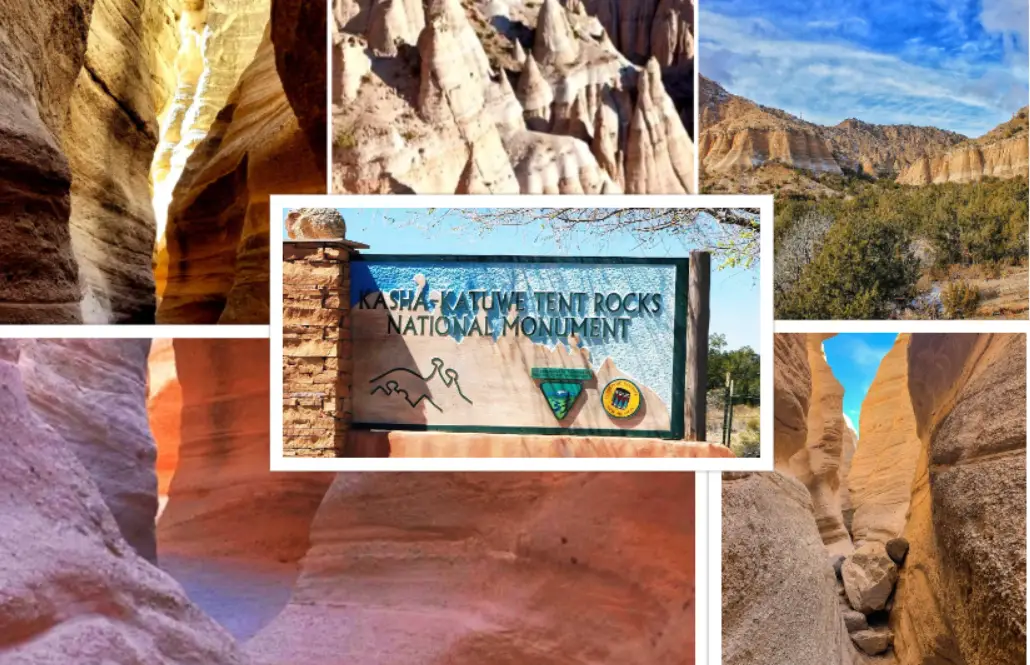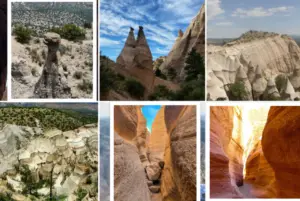Kasha-Katuwe Tent Rocks : Interesting Facts, History & Travel Guide

- By
- Aparna Patel
- |
- 11 Apr, 2023
- |

Welcome to our travel blog, where we take you on a journey to one of the most unique geological formations in the United States – the Kasha-Katuwe Tent Rocks National Monument. This natural wonder, located in north-central New Mexico, is a product of millions of years of volcanic eruptions and erosion, resulting in cone-shaped formations that resemble tents, some towering as high as 90 feet.
In this blog post, we will share with you interesting facts about the history and formation of the monument, as well as a comprehensive travel guide to help you plan your visit.
From the sacred significance of the area to the diverse array of flora and fauna that call it home, we will explore the many facets of Kasha-Katuwe Tent Rocks National Monument.
Whether you’re an avid hiker or just looking for a unique outdoor adventure, this post has everything you need to know to make the most of your visit. So pack your bags, grab your hiking boots, and let’s dive into the beauty and wonder of Kasha-Katuwe Tent Rocks National Monument!
Table of Contents
Interesting facts about Kasha-Katuwe Tent Rocks National Monument
- Formation: The tent rocks were formed by volcanic eruptions that occurred about 6 to 7 million years ago. The volcanic ash and pumice were eroded by wind and water over time, creating the unique cone-shaped formations that resemble tents.
- Location: The national monument is located on the Pajarito Plateau, between Albuquerque and Santa Fe, in the Rio Grande Valley. It covers an area of about 4,000 acres and includes two main hiking trails.
- Sacred Site: The area has been sacred to the Puebloan people for centuries, and they still use it for traditional ceremonies today. The name Kasha-Katuwe means “white cliffs” in the Pueblo language.
- Diversity: The monument is home to a wide variety of plants and animals, including over 140 bird species, coyotes, rabbits, and lizards.
- Hiking Trails: There are two main hiking trails in the monument: the Cave Loop Trail and the Canyon Trail. The Cave Loop Trail is an easy 1.2-mile hike that takes visitors past some of the most impressive tent rocks and through a narrow slot canyon. The Canyon Trail is a more challenging 1.5-mile hike that climbs up to the top of the mesa and offers stunning views of the surrounding landscape.
- Geological research: The monument is also an important site for geological research, as it provides a unique opportunity to study the effects of volcanic eruptions and erosion on the landscape.
- Visitor Center: The monument has a visitor center where visitors can learn more about the area’s geology, ecology, and history. The center also has exhibits, a bookstore, and restrooms.
- Weather: The best time to visit Kasha-Katuwe Tent Rocks National Monument is in the spring or fall when the weather is mild. Summers can be hot and dry, while winters can be cold and snowy.
- Preservation: The monument is managed by the Bureau of Land Management (BLM) and is protected as a National Monument to ensure its preservation for future generations.
Can you see Tent Rocks without hiking?
While the best way to experience and appreciate the beauty of the Kasha-Katuwe Tent Rocks National Monument is through hiking, there is a way to see the tent rocks without hiking. The monument has a scenic drive that provides visitors with a view of the tent rocks from a distance. The drive is a dirt road that is approximately 6 miles long and takes visitors through the canyon and up to a vista point that offers a panoramic view of the surrounding landscape, including the tent rocks.
However, please note that the scenic drive does not offer a close-up view of the tent rocks, and it is not possible to explore the formations or experience the narrow slot canyon without hiking. Additionally, the dirt road may be rough and unsuitable for some vehicles, so it’s important to check the road conditions before attempting the scenic drive.
Overall, hiking is highly recommended for those who want to fully experience and appreciate the beauty of Kasha-Katuwe Tent Rocks National Monument.
Read More:
- Utah – Jurassic National Monument : Interesting Facts, History & Travel Guide
- John Day Fossil Beds : Interesting Facts, History & Travel Guide
- Jewel Cave National Monument : Interesting Facts, History & Travel Guide
- Ironwood Forest National Monument : Interesting Facts, History & Travel Guide
- Hovenweep National Monument : Interesting Facts, History & Travel Guide
- Hohokam Pima National Monument : Interesting Facts, History & Travel Guide
- Harriet Tubman Underground Railroad National Monument : Interesting Facts, History & Travel Guide
Information & History of Kasha-Katuwe Tent Rocks National Monument
Kasha-Katuwe Tent Rocks National Monument is a unique geological formation located in north-central New Mexico, USA. It was established as a National Monument in 2001 to protect its distinctive landscape, which is a product of volcanic eruptions and erosion.
The formation of the monument can be traced back to a series of volcanic eruptions that occurred between 6 and 7 million years ago. The eruptions deposited layers of volcanic ash and pumice, which were later eroded by wind and water. Over time, this erosion created the unique cone-shaped formations that resemble tents, some of which stand as tall as 90 feet.
The Kasha-Katuwe Tent Rocks area has long been sacred to the Puebloan people, who have used it for traditional ceremonies for centuries. The name “Kasha-Katuwe” means “white cliffs” in the Pueblo language.
The land that now makes up the monument was originally part of the Cochiti Pueblo reservation, but it was later transferred to the Bureau of Land Management (BLM). The area was designated as a National Monument in 2001, and it is now managed by the BLM.
In addition to its unique geological formations, Kasha-Katuwe Tent Rocks National Monument is also home to a diverse array of flora and fauna. The area provides habitat for over 140 species of birds, as well as coyotes, rabbits, and lizards.
Visitors to the monument can explore two main hiking trails: the Cave Loop Trail and the Canyon Trail. The Cave Loop Trail is an easy 1.2-mile hike that takes visitors past some of the most impressive tent rocks and through a narrow slot canyon. The Canyon Trail is a more challenging 1.5-mile hike that climbs up to the top of the mesa and offers stunning views of the surrounding landscape.
The monument also has a visitor center where visitors can learn more about the area’s geology, ecology, and history. The center has exhibits, a bookstore, and restrooms.
Kasha-Katuwe Tent Rocks National Monument is an important site for geological research, as it provides a unique opportunity to study the effects of volcanic eruptions and erosion on the landscape. Its establishment as a National Monument ensures its preservation for future generations to enjoy and appreciate.
Travel Guide for Kasha-Katuwe Tent Rocks National Monument
- When to go: The best time to visit the monument is in the spring or fall when the weather is mild and comfortable for hiking. Summer can be hot and crowded, while winter can be cold and snowy.
- How to get there: The monument is located approximately 40 miles southwest of Santa Fe, New Mexico. The closest airport is the Albuquerque International Sunport, which is approximately 60 miles away. From there, you can rent a car or take a shuttle to the monument.
- Where to stay: There are no lodging options within the monument, but there are plenty of nearby options in Santa Fe and Albuquerque. There are also several camping options available within the monument, including a developed campground and a primitive camping area.
- Visitor center: The monument has a visitor center where you can learn more about the area’s geology, ecology, and history. The center has exhibits, a bookstore, and restrooms.
- What to bring: Be sure to wear comfortable hiking shoes, sunscreen, and a hat. Bring plenty of water, as there are no water sources along the trails. You may also want to bring snacks and a camera to capture the stunning views.
- Rules and regulations: The monument is a protected area, and there are several rules and regulations that visitors must follow. Stay on designated trails, pack out all trash, and respect the sacred significance of the area to the Puebloan people.
More Article
- Hanford Reach National Monument : Interesting Facts, History & Travel Guide
- Hagerman Fossil Beds National Monument : Interesting Facts, History & Travel Guide
- Grand Staircase–Escalante National Monument : Interesting Facts, History & Travel Guide
- Grand Portage National Monument : Interesting Facts, History & Travel Guide
Overall, Kasha-Katuwe Tent Rocks National Monument is a unique and beautiful destination that offers a glimpse into the geological history of the region. With stunning views, challenging hikes, and a rich cultural heritage, it’s a must-see for any outdoor enthusiast or nature lover.
Search Posts
Latest posts
-
4 Mar, 2024
How can I do a "broad" search for flights?
-
4 Mar, 2024
How to make dining alone less awkward?
Popular posts
-
5 Mar, 2024
Why prohibit engine braking?
